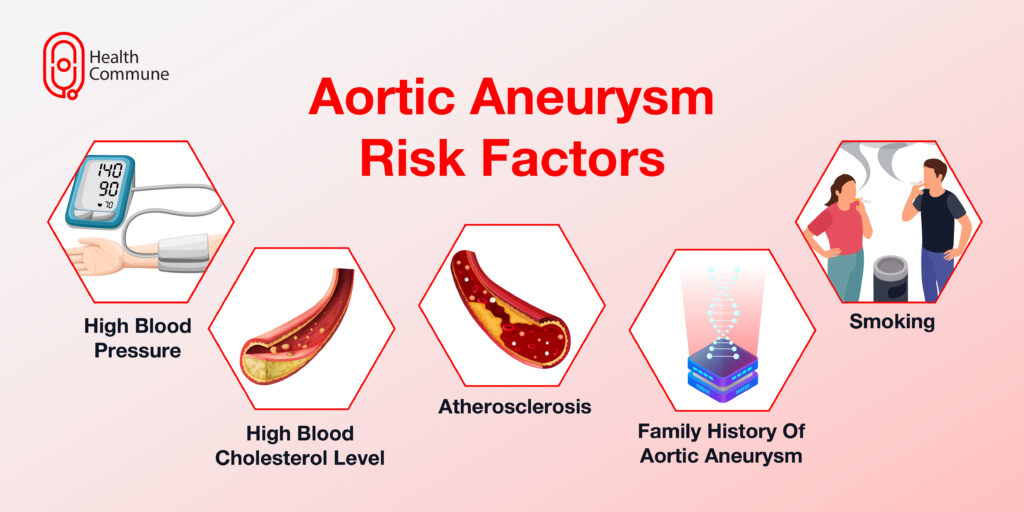Aortic aneurysms are associated with a considerable risk of sudden death. Learn all about their symptoms, causes and treatment.
What is an aortic aneurysm?
An aortic aneurysm is an abnormal balloon-like swelling or bulge that develops in the aorta due to weakening its walls.
The aorta is the largest artery in our body, carrying oxygenated blood to various tissues and organs. It travels from the heart and goes to the chest and abdomen before branching out into the pelvis. In the chest, it is called the ‘thoracic aorta’ and in the abdomen, it is called the ‘abdominal aorta’.
Why are aortic aneurysms so dangerous?
Are aortic aneurysms common in India?
Cardiovascular diseases are currently the leading cause of death in India. Aortic aneurysms are steadily on the rise, especially among the elderly population. A high mortality rate accompanies them.
Are there different types of aortic aneurysms?
Depending on the location, they can be classified into:
- Thoracic aortic aneurysm: In this, the upper part of the aorta gets weakened. This is seen with increasing age and affects both men and women equally. These are usually caused by high blood pressure, injuries or certain inherited connective tissue disorders such as Marfan’s syndrome and Ehler-Danlos syndrome.
- Abdominal aortic aneurysm (AAA): This affects the abdominal part of the aorta. This predominantly affects men and is seen among people over the age of 65 years. AAAs develop as a result of atherosclerosis, smoking, high blood pressure or vasculitis.
Who’s at a higher risk of developing an aortic aneurysm?
You’re more susceptible to developing this condition if you:
- Have high blood pressure
- Have high cholesterol levels
- Are you suffering from atherosclerosis (blood vessels becoming narrow because of the deposition of fat or plaque)
- Are you smoking or used to smoke in the past
- Have a family history of aortic aneurysms

What are the symptoms of an aortic aneurysm?
An aneurysm can take years to develop and you may not even know you have it until:
- It tears open (aortic rupture)
- There is leakage of blood along the aorta’s wall (aortic dissection)
- It enlarges and presses on nearby structures
You may experience the following symptoms:
- Chest pain
- Back pain
- A pulsating sensation in the abdomen (in the case of AAA)
- Breathlessness or high-pitched breathing
- Difficulty in swallowing
- Coughing
- Hoarseness of voice
- Clammy skin
- Nausea and vomiting
- Rapid heart rate or palpitations
- Dizziness or passing out
How is an aortic aneurysm diagnosed?
An unruptured aortic aneurysm is a silent disease, not usually picked up unless your doctor is examining you for some other condition or you’re undergoing a routine health check-up, or you’re at a higher risk of developing the disease. If your doctor suspects you’re suffering from this condition, they will refer you for:
- Abdominal ultrasound scan: This gives a rough idea of the size of the aneurysm. If it’s small, your doctor will suggest to undergo routine ultrasound screening to keep an eye on it and make sure it doesn’t get bigger
- CT or MRI scan: In case the aneurysm is bigger or if you’re experiencing symptoms, your doctor will ask you to get a CT or MRI scan done
How are aortic aneurysms treated?
The treatment is planned based on the size of the aneurysm. If it is small, your doctor will prescribe medications to lower your blood pressure, such as beta-blockers, to decrease its chances of getting worse or rupturing.
If its size is bigger and you are experiencing symptoms, your doctor will recommend surgery:
- Open surgery: This type of surgery is required if aneurysm is very large or has ruptured
- Endovascular repair: This is a less invasive procedure and is done in a cath lab.
- Your doctor makes a small surgical cut near your groin and inserts a guide wire into the femoral artery up to the aneurysm
- He then inserts a catheter over the guide wire
- This catheter carries a stent (metallic coil) and a synthetic graft to your aorta, above the level of the aneurysm
- Once in place, the graft is released from the catheter and it expands to block the blood flow and causes it to shrink over time
What happens after surgery?
You will be required to stay in the hospital for 3-5 days post-surgery.
- Initially, you will be required to stay in the intensive care unit (ICU) and be watched closely to ensure that the surgery is successful
- You will have a urinary catheter and be put on blood thinners and painkillers
- You will also be prescribed special stockings to prevent the development of blood clots in your legs
What are the complications of surgery?
While endovascular repair comes with fewer complications, both types of surgeries present the risk of
- Bleeding
- Infections
- Formation of blood clots, which may lead to pulmonary embolism, stroke or heart attack
- Kidney failure
In the case of endovascular surgery, there is a small probability of the graft slipping out of position as well.
What if I don’t treat the aortic aneurysm?
Can I get a second aneurysm even after surgery?
How can I reduce my risk of getting an aortic aneurysm?
You can make simple lifestyle modifications to decrease your risk. which include:
- Quitting smoking
- Consume alcohol in moderation
- Exercising regularly
- Getting routine health check-ups
- Controlling your blood pressure and cholesterol levels
- Decreasing your stress levels
Can aneurysms occur in other parts of the body as well?
Yes, they can occur in any blood vessel. If they are present in the brain, their rupture can lead to a stroke. Other potential sites include the leg, the intestines and the spleen.




